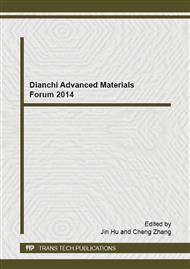p.30
p.35
p.40
p.44
p.48
p.52
p.56
p.61
p.65
Preparation of Sub-Micrometre Size Platinum Particles via Chemical Reduction of Hexachloroplatinic Acid in Aqueous Solution
Abstract:
The sub-micrometre size platinum particles via chemical reduction of hexachloroplatinic acid in aqueous solution was investigated by UV-Visible Spectroscopy, Transmission Electron Microscopy, X-ray diffraction and FTIR Spectroscopy. Hydrazine hydrate was used as the reducing agent, and polyvinylpyrrolidone (PVP-K30) was used for stabilizing the particles. By varying the amount of PVP-K30 the average diameter of the platinum particles could be adjusted. The TEM and XRD results revealed that the final sub-micrometre size Pt particles were the result of an aggregation of small (~5 nm) nanoparticles. The UV-Visible Spectroscopy and FTIR Spectroscopy investigations indicates the mechanism of anti-aggregation of Pt particles by the steric effect of PVP-K30.
Info:
Periodical:
Pages:
48-51
Citation:
Online since:
November 2014
Authors:
Price:
Сopyright:
© 2014 Trans Tech Publications Ltd. All Rights Reserved
Share:
Citation:


